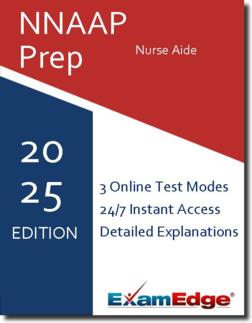NNAAP Nurse Aide Practice Tests & Test Prep by Exam Edge - Topics
Based on 17 Reviews
- Real Exam Simulation: Timed questions and matching content build comfort for your NNAAP Nurse Aide test day.
- Instant, 24/7 Access: Web-based NNAAP National Nurse Aide Assessment Program (NNAAP) practice exams with no software needed.
- Clear Explanations: Step-by-step answers and explanations for your NNAAP exam to strengthen understanding.
- Boosted Confidence: Reduces anxiety and improves test-taking skills to ace your NNAAP National Nurse Aide Assessment Program (NNAAP) .

Understanding the exact breakdown of the NNAAP National Nurse Aide Assessment Program (NNAAP) test will help you know what to expect and how to most effectively prepare. The NNAAP National Nurse Aide Assessment Program (NNAAP) has 70 multiple-choice questions The exam will be broken down into the sections below:
| NNAAP National Nurse Aide Assessment Program (NNAAP) Exam Blueprint | ||
|---|---|---|
| Domain Name | % | Number of Questions |
| Physical Care Skills - Activities of Daily Living | 14% | 10 |
| Physical Care Skills - Basic Nursing Skills | 39% | 27 |
| Physical Care Skills - Restorative Skills | 7% | 5 |
| Psychosocial Care Skills - Emotional and Mental Health Needs | 11% | 8 |
| Psychosocial Care Skills - Spiritual and Cultural Needs | 2% | 1 |
| Role of the NA - Communication | 8% | 6 |
| Role of the NA - Client Rights | 7% | 5 |
| Role of the NA - Legal and Ethical Behavior | 3% | 2 |
| Role of the NA - Member of the Health Care Team | 9% | 6 |


